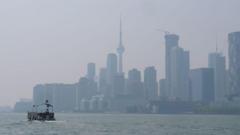Smoke from Canadian wildfires has begun wafting into the Upper Midwest, prompting health advisories across Michigan, Wisconsin, and Minnesota where air quality has deteriorated. Authorities have issued warnings for residents to limit outdoor activities, especially those in sensitive groups, due to elevated levels of particulate pollution.
Smoke from Canadian Wildfires Blankets U.S. Upper Midwest, Prompting Health Advisories
Smoke from Canadian Wildfires Blankets U.S. Upper Midwest, Prompting Health Advisories
Wildfire smoke from Canada raises serious health concerns across Michigan, Wisconsin, and Minnesota as residents are urged to limit outdoor activities.
As wildfires rage in Manitoba and Saskatchewan, meteorologists warn that smoke may linger for several days, with health impacts expected. In Michigan, the Department of Environment, Great Lakes and Energy noted that fine particulate levels would remain elevated through Saturday morning. Sensitive groups, including individuals with heart or lung conditions, older adults, children, and pregnant individuals, are particularly at risk.
Wildfire season in Canada is typically active from March to October, but recent conditions have intensified, with two fatalities reported in Manitoba this month amid the onset of significant fire activity. Dozens of wildfires have triggered evacuations in Saskatchewan and Manitoba as the fire season unfolds.
In Minnesota, air quality levels have registered red on the air quality index, indicating unhealthy conditions for the general public, while areas further from the fires are expected to reach orange levels, which pose risks to sensitive groups. The Minnesota Pollution Control Agency has indicated that this smoke event could span multiple days, expecting significant concentrations through Saturday afternoon followed by subsequent waves of smoke over the weekend.
Wisconsin is similarly affected, with hazy skies and health advisories in place predicting worsening air quality spreading southward. Officials emphasize that air quality could remain poor beyond the initial advisories, indicating a serious and prolonged exposure risk for many residents.
As communities in the Upper Midwest grapple with the effects of fire-induced air pollution, it remains critical for residents to stay informed and take necessary precautions to protect their health during this seasonal crisis.
Wildfire season in Canada is typically active from March to October, but recent conditions have intensified, with two fatalities reported in Manitoba this month amid the onset of significant fire activity. Dozens of wildfires have triggered evacuations in Saskatchewan and Manitoba as the fire season unfolds.
In Minnesota, air quality levels have registered red on the air quality index, indicating unhealthy conditions for the general public, while areas further from the fires are expected to reach orange levels, which pose risks to sensitive groups. The Minnesota Pollution Control Agency has indicated that this smoke event could span multiple days, expecting significant concentrations through Saturday afternoon followed by subsequent waves of smoke over the weekend.
Wisconsin is similarly affected, with hazy skies and health advisories in place predicting worsening air quality spreading southward. Officials emphasize that air quality could remain poor beyond the initial advisories, indicating a serious and prolonged exposure risk for many residents.
As communities in the Upper Midwest grapple with the effects of fire-induced air pollution, it remains critical for residents to stay informed and take necessary precautions to protect their health during this seasonal crisis.



















